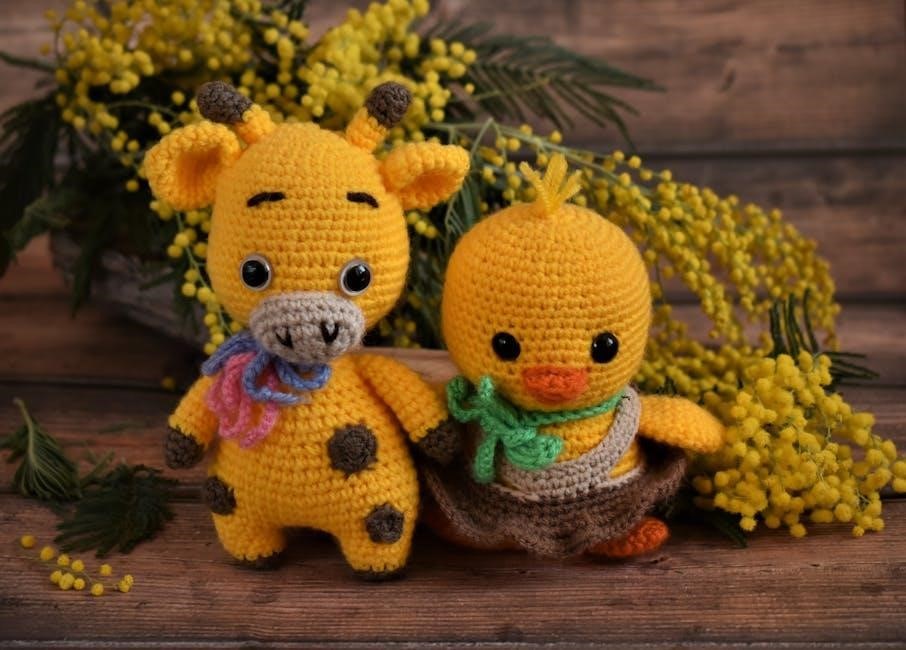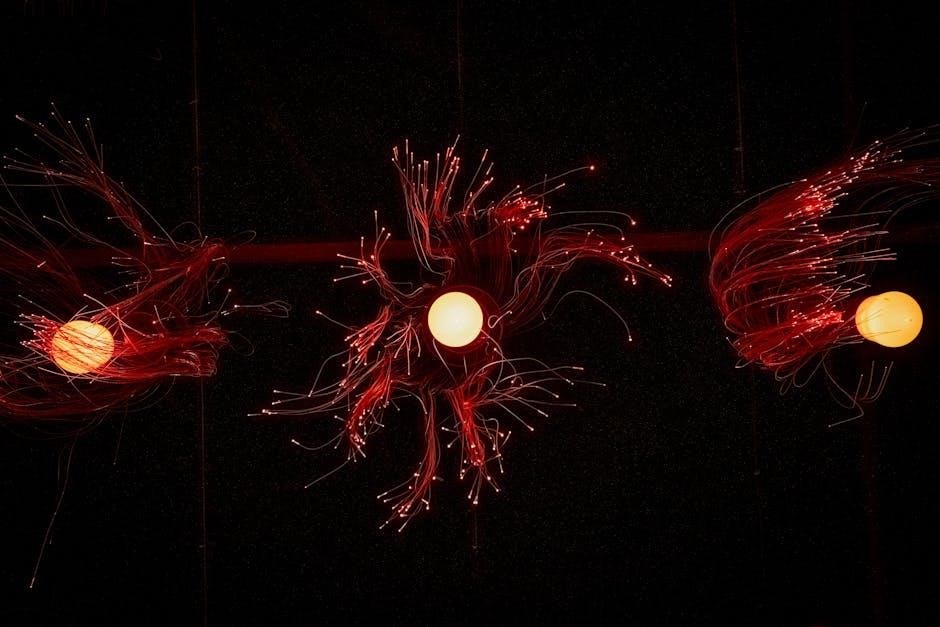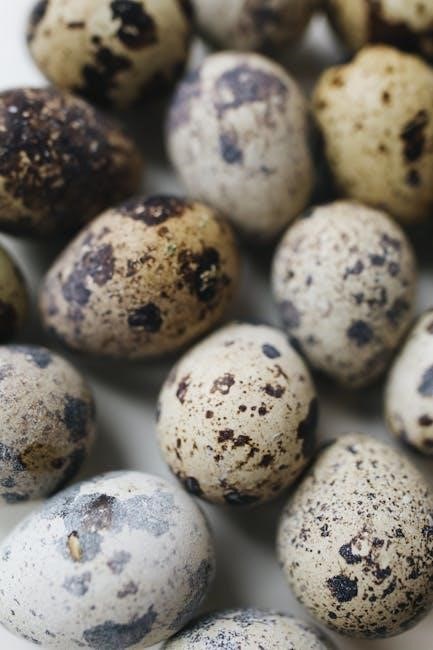Amigurumi is a beloved Japanese crochet craft, perfect for creating adorable characters or heartfelt gifts. Free PDF patterns make this delightful hobby accessible to everyone, fostering creativity and joy.
1.1 What is Amigurumi?
Amigurumi is a traditional Japanese crochet craft that focuses on creating small, cute characters or objects. The word “amigurumi” combines “ami” (to knit or crochet) and “nuigurumi” (stuffed toy). It involves using crochet hooks and yarn to craft adorable designs, often with oversized heads, small limbs, and expressive features. The charm of amigurumi lies in its ability to bring joy and warmth through handmade creations, making it a beloved hobby worldwide. Its simplicity and versatility have made it accessible to crafters of all skill levels, fostering creativity and connection.
1.2 The Popularity of Amigurumi Crafting
Amigurumi crafting has gained immense popularity globally, charming crafters with its whimsical designs and therapeutic benefits. The rise of social media platforms showcasing adorable creations has fueled its growth, making it a trend among hobbyists. Free PDF patterns have further boosted accessibility, allowing everyone to join in the fun. Its appeal lies in creating personalized gifts and decorations, fostering a sense of accomplishment and joy. This craft’s universal charm continues to inspire new generations of creators, ensuring its enduring popularity.
1.3 Why Choose Free PDF Patterns?
Choosing free PDF patterns offers unparalleled convenience and affordability for crafters. These downloadable files provide instant access to detailed instructions, enabling you to start projects immediately. Perfect for beginners, they often include clear guides and visuals. Free patterns also allow experimentation without financial commitment, helping you explore various styles and techniques. Additionally, they foster creativity by offering a wide range of designs to suit different skill levels and interests. This accessibility makes free PDF patterns an ideal choice for hobbyists worldwide.

Where to Find Free Amigurumi Patterns
Discover countless free Amigurumi PDF patterns on official designer websites, social media platforms, crafting forums, and blog sites, making it easy to find your next project.
2.1 Official Websites and Designers
Official websites and independent designers are reliable sources for free Amigurumi PDF patterns. Many designers offer complimentary patterns to showcase their work or promote yarn brands. These patterns are often high-quality, well-tested, and include clear instructions. Visiting the official websites of yarn manufacturers or crochet tool brands can also yield free downloadable patterns. Additionally, subscribing to newsletters or following designers on social media often grants access to exclusive freebies. Always verify the source for authenticity and quality to ensure a seamless crafting experience.
2.2 Social Media Platforms
Social media platforms like Facebook, Instagram, and Pinterest are treasure troves for free Amigurumi PDF patterns. Many designers share their creations through groups or direct downloads. Follow crochet communities, join Amigurumi-specific groups, or search hashtags like #AmigurumiPatterns or #FreeCrochetPatterns. Platforms like Ravelry also host a wealth of user-shared designs. Engaging with these communities allows you to discover new patterns, connect with fellow crafters, and stay updated on the latest trends. Always check the permissions and give proper credit to designers when using their work.
2.3 Crafting Communities and Forums
Crafting communities and forums are excellent sources for free Amigurumi PDF patterns. Platforms like Ravelry, Facebook groups, and Reddit communities (e.g., r/crochet or r/Amigurumi) offer a wealth of shared patterns. These spaces allow users to search, download, and engage with fellow crafters. Many designers share their work freely, and forums often include tips, tutorials, and discussions to help beginners. Sharing your finished projects and getting feedback from these communities can also be incredibly motivating and rewarding. They are a great way to connect and grow as a crafter.
2.4 Blog Websites
Blog websites are a fantastic resource for finding free Amigurumi PDF patterns. Many craft bloggers share their designs, often with detailed tutorials and step-by-step photos. These blogs are curated by designers who specialize in Amigurumi, ensuring high-quality patterns. You can search for specific themes or browse through collections. Blog websites also offer a sense of community, as readers often share their finished projects and experiences. Many blogs provide patterns for free, making them a great starting point for crafters of all skill levels.
Types of Amigurumi Patterns
Amigurumi patterns offer a wide variety of designs, from cute animals and charming characters to seasonal themes and unique creations. Each type sparks creativity and delight.
3.1 Animal Patterns
Animal patterns are a favorite among amigurumi crafters, offering a wide range of adorable creatures. From cuddly cats and playful puppies to exotic wildlife, these patterns allow for endless creativity. Crafters can create realistic animals or add whimsical touches, making each piece unique. The ability to personalize details, such as eye styles or expressions, adds charm. These patterns are perfect for gifts or home decor, appealing to both beginners and experienced makers. The variety ensures there’s something for every animal lover to enjoy.
3.2 Humanoid and Character Patterns
Humanoid and character patterns bring beloved personalities to life, offering endless opportunities for creativity; These designs often feature anthropomorphic characters, blending human traits with imaginative twists. From superheroes to fantasy creatures, crafters can create unique, expressive figures. The ability to customize outfits, accessories, and facial expressions allows for personalization. These patterns cater to various skill levels, making them accessible to both beginners and experienced makers. Ideal for personalized gifts or collectibles, humanoid patterns inspire storytelling and emotional connections through crochet artistry.
3.3 Seasonal and Holiday Patterns
Seasonal and holiday patterns add a festive touch to amigurumi crafting. These designs cater to celebrations like Christmas, Halloween, Easter, and more. Crafters can create themed characters, ornaments, or decorations. Patterns often include specific details like Santa hats, pumpkin costumes, or Easter eggs. They provide a creative way to personalize gifts or home decor. Seasonal patterns also introduce unique yarn color choices and embellishments. Whether for gifting or personal enjoyment, these designs keep amigurumi fresh and exciting throughout the year. They cater to all skill levels, ensuring everyone can join in the seasonal fun.
3.4 Hybrid and Mixed Patterns
Hybrid and mixed patterns offer a creative twist by combining amigurumi with other crafts or techniques. These designs blend crochet with knitting, embroidery, or fabric, creating unique textures and styles. Mixed patterns might merge animals with human features or incorporate seasonal elements into character designs. They allow crafters to experiment with diverse materials and methods, pushing the boundaries of traditional amigurumi. These patterns are perfect for those seeking complexity and customization in their projects. They also cater to crafters who enjoy combining skills or exploring fresh artistic expressions.

Materials and Tools Needed
Essential materials include high-quality yarn, crochet hooks of various sizes, stuffing material, and basic tools like scissors and stitch markers. These basics help crafters bring their amigurumi projects to life.
4.1 Yarn Selection
Choosing the right yarn is crucial for amigurumi projects. Acrylic yarn is popular for its softness, durability, and vibrant colors. Cotton yarn is ideal for a more natural feel and is breathable, making it perfect for toys. Blends offer a balance between softness and strength. Consider the weight and size of the yarn, as thicker yarns work up faster but may lack detail. Always check the yarn’s fiber content and care instructions to ensure it suits your project’s needs. Color variety allows for personalization, making your amigurumi unique. Budget and availability are also key factors, so explore options to find the best fit for your craft. Testing the yarn with a small gauge swatch can help ensure consistency in your stitches and the overall appearance of your amigurumi creation.
4;2 Crochet Hooks
Choosing the right crochet hook is essential for amigurumi success. Hooks come in various materials, such as steel, aluminum, or plastic, each offering different benefits. Size matters—too small, and your stitches will be tight; too large, and your fabric may be loose. Always check the pattern for recommended hook sizes, as this ensures your project turns out the right size. Ergonomic handles can make crocheting more comfortable, especially for long sessions. Using the correct hook size is crucial for maintaining the shape and appearance of your amigurumi. The right hook ensures a polished and professional finish.
4.3 Stuffing Materials
Proper stuffing materials are crucial for giving your amigurumi its shape and cuddliness. The most common choice is polyester fiberfill, which is soft, easy to work with, and holds its shape well. Wool or cotton batting can also be used for a more natural feel. When stuffing, use small handfuls and gently press the material into the shape, ensuring no lumps form. Overstuffing can make the toy rigid, while under-stuffing may leave it limp. The right stuffing material and technique bring your amigurumi to life, making it both adorable and huggable.
4.4 Additional Tools

Beyond the basics, several tools enhance your amigurumi crafting experience. Sharp scissors are essential for cutting yarn cleanly. A tapestry needle is ideal for weaving in ends. Stitch markers help track rounds or specific stitches. A stuffing tool or chopstick can assist in reaching tight spaces. A measuring tape ensures accurate sizing. Optional tools include embroidery floss for details like eyes or mouths, and a stitch dictionary for quick reference. Having these tools on hand makes the process smoother and more enjoyable, allowing you to focus on creating your adorable amigurumi designs.

Step-by-Step Guide to Using Free PDF Patterns
Download, print, and review the pattern. Understand symbols, abbreviations, and materials. Start crocheting, follow row-by-row instructions, and assemble pieces. Perfect for beginners and experienced crafters alike.
5.1 Downloading and Printing Patterns
Downloading free PDF amigurumi patterns is simple. Visit trusted websites, click the download link, and save the file. Print on standard paper, ensuring the scale is accurate. Use a binder to store patterns neatly; Always check for updates or corrections. Be mindful of copyright and usage rights. Printing patterns allows for easy reference while crocheting. Adjust printer settings to ensure clarity and proper sizing. This step is essential for a smooth crafting experience, so take your time to organize your materials. Happy crafting!
5.2 Understanding Pattern Symbols
Amigurumi patterns use specific symbols to guide crocheters. These symbols represent stitches, increases, decreases, and other techniques. Familiarize yourself with the key provided, as it varies by designer. Common symbols include circles for single crochet, arrows for increases, and crosses for decreases. Always cross-reference with the pattern’s glossary or tutorial links. Understanding these symbols ensures accurate stitching and a professional finish. For beginners, practice with scrap yarn to master each symbol’s corresponding stitch before starting your project. This step is crucial for achieving the desired results.
5.3 Starting Your Project
Begin by gathering all materials and tools listed in the pattern. Read through the instructions carefully to understand the sequence. Start with a swatch to ensure proper tension and stitch size; Many patterns begin with a magic ring or chain, setting the foundation for the project. Pay attention to the starting stitch count, as it impacts the overall shape. Double-check hook size and yarn weight recommendations for best results. A well-prepared start leads to a successful amigurumi creation.
5.4 Following Instructions
Following instructions carefully ensures your amigurumi project turns out as intended. Begin by reading the pattern thoroughly, noting abbreviations and symbols. Pay attention to specific techniques like magic rings or chains. Follow the sequence of increases and decreases to achieve the desired shape. Maintain consistent tension and stitch count to ensure proper sizing. Each round builds on the previous one, so accuracy is key. For beginners, consider marking the end of rounds and counting stitches regularly. Trust the pattern and enjoy the creative process!

Tips for Beginners
Starting with simple patterns, choose the right tools and yarn. Practice basic stitches and patience. Learn to read patterns, manage tension, and handle stuffing. Focus on these key areas to ensure success.
6.1 Choosing the Right Yarn
Choosing the right yarn is crucial for amigurumi projects. Opt for medium-weight, non-splitting yarns like acrylic or cotton blends. These fibers provide durability and a soft texture. Avoid too bulky yarns as they can make details less visible. Consider color choices that match your character or theme. Always check the yarn weight and fiber content in your pattern to ensure the best results. Proper yarn selection enhances both appearance and longevity of your amigurumi creations.
6.2 Mastering Basic Stitches
Mastering basic stitches is essential for successful amigurumi projects. Start with the magic ring and single crochet (sc), as these are foundational. Practice increasing (inc) and decreasing (dec) stitches to shape your creations. Even tension is crucial to maintain a tight fabric and prevent holes. Begin with scrap yarn to build confidence before starting your project. Refer to tutorials or pattern guides for clear step-by-step instructions. Consistent practice will help you achieve professional-looking results and make your amigurumi projects truly special.
6.3 Stuffing Techniques
Proper stuffing techniques bring your amigurumi to life. Use a high-quality polyester fiberfill for a soft, even texture. Start by lightly stuffing the body, ensuring no lumps form; Use a chopstick or stuffing tool to reach small spaces, like limbs or ears. Avoid overstuffing, as it can make the fabric tight and cause seams to split.Stuff firmly enough to maintain shape but gently enough to keep the fabric flexible. This balance ensures your creation is cuddly and durable for years to come.
6.4 Adding Facial Features
Facial features are the heart of your amigurumi’s personality. Use embroidery floss or safety eyes for expressive details. For embroidery, use a sharp needle and contrasting thread to create eyes, eyebrows, and a mouth. Safety eyes are quick and easy, offering a cute, professional look. Place features symmetrically, using the pattern as a guide. Experiment with expressions to match your character’s personality. Properly securing these details ensures durability and prevents them from coming loose over time, making your amigurumi truly special and long-lasting.
Common Mistakes to Avoid
Avoiding common mistakes is crucial for perfect amigurumi results. Issues like uneven tension, miscounted stitches, or improper stuffing can ruin your project. Stay attentive and patient.
7.1 Incorrect Tension
Incorrect tension is a common mistake that can ruin an amigurumi project. If the stitches are too tight, the fabric becomes stiff, and the toy may lose its soft, cuddly appeal. Conversely, stitches that are too loose can result in a floppy, misshapen figure. To avoid this, always check your tension regularly. Use the recommended hook size and practice basic stitches to maintain consistency. Even slight variations can affect the final shape, so staying mindful of your yarn handling is key to achieving professional-looking results;

7.2 Miscounting Stitches
Miscounting stitches is a frequent error that can lead to mismatched limbs, distorted shapes, or an entirely different design. Amigurumi patterns rely heavily on precise stitch counts to achieve the desired form and symmetry. Always double-check your work after each round or row, as even a single missed stitch can throw off the entire project. Using stitch markers or a counter can help maintain accuracy. Correcting mistakes early saves time and frustration, ensuring your amigurumi turns out as charming and cohesive as intended.
7.3 Improper Stuffing
Improper stuffing is a common issue that can ruin the appearance of your amigurumi. Over-stuffing makes the toy rigid and misshapen, while under-stuffing leaves it limp and flat. Use polyester fiberfill for the best results, as it holds its shape well. Stuff firmly but gently, ensuring even distribution. For hollow or complex shapes, use a stuffing tool or chopstick to reach tight spaces. Always stuff as you go, before closing the opening, to maintain the desired form and prevent lumps or gaps in your finished piece.
7.4 Ignoring Pattern Details

Ignoring pattern details is a mistake that can lead to misshapen or poorly proportioned amigurumi toys. Every instruction, from specific stitches to shaping techniques, is included for a reason. Skipping steps or failing to follow gauge guidelines can result in toys that look nothing like the intended design. Always read patterns thoroughly, pay attention to abbreviations, and ensure you understand the instructions before starting. Taking the time to follow every detail will help you achieve professional-looking results and make your project more enjoyable.

Advanced Techniques for Amigurumi
Mastering advanced techniques like color changing, shape manipulation, and detail addition elevates your amigurumi craft, allowing for intricate designs and personalized creations that stand out.
8.1 Color Changing
Color changing is a key advanced technique in amigurumi, allowing for vibrant, multi-tonal designs. It involves seamlessly transitioning between yarn colors mid-project. To achieve this, crochet enthusiasts often use methods like carrying yarn, working with bobbins, or employing stitch markers to keep track of color shifts. Proper tension and timing are crucial to maintain the amigurumi’s texture and shape. Many free PDF patterns include detailed guidance on color changing, making it accessible even for those new to this skill. Practice and patience will help refine this technique for stunning results.
8.2 Shape Manipulation
Shape manipulation is an advanced amigurumi technique that allows crochet enthusiasts to create unique and intricate designs. By adjusting stitch counts, increasing, or decreasing strategically, crafters can alter the basic forms of their projects. This method enables the creation of asymmetrical shapes, curved features, or even complex structures. Many free PDF patterns include tips for mastering shape manipulation, making it easier for crafters to experiment and personalize their amigurumi creations. With practice, this technique can elevate projects, adding depth and character to every stitch.
8.3 Adding Details
Adding details is a crucial step in bringing amigurumi characters to life. From embroidery floss for eyes and mouths to appliques for clothing, these small touches add personality and charm. Many free PDF patterns include guides for adding intricate details, such as buttons, bows, or even textured elements. Crafters can also experiment with fabric paint or felt for unique accents. These finishing touches allow for endless customization, making each amigurumi piece truly one-of-a-kind and filled with character. Details are what transform a simple shape into a beloved companion or gift.
8.4 Customizing Patterns
Customizing amigurumi patterns allows crafters to infuse personal flair into their creations. Adjusting sizes, altering colors, or modifying features can transform a basic design into a unique piece. Experimenting with yarn weights, stitch variations, or combining elements from multiple patterns can also yield original designs. Additionally, crafters can add personalized touches like accessories or themed embellishments. Free PDF patterns often serve as a foundation, enabling creativity and flexibility for those who enjoy tweaking designs to suit their preferences or match specific themes.

Troubleshooting Common Issues
Troubleshooting is key to resolving common amigurumi issues like fabric holes, shape problems, or stitch errors, often fixed with simple adjustments and careful attention to detail.
9.1 Fixing Holes in the Fabric
Holes in amigurumi fabric can occur due to loose stitches or improper tension. To fix them, tighten stitches by crocheting more densely or use a tapestry needle to weave yarn through gaps. Adding a lining with fabric or felt can also prevent holes from forming. Ensure even tension while crocheting to avoid future issues. Patience and careful stitching are key to achieving a smooth, professional finish. This step is crucial for maintaining the structural integrity and appearance of your amigurumi creation.
9.2 Adjusting the Shape
If your amigurumi project isn’t shaping as expected, don’t worry! Use stitch markers to track rounds and ensure even increases or decreases. For parts that feel too loose or tight, try adjusting your hook size or yarn weight. Adding extra rounds or decreasing stitches strategically can correct proportions. If a section is misshapen, frogging (ripping out) and reworking it is often the best solution. Proper shaping ensures your amigurumi looks adorable and professional, so take the time to tweak as needed for the best results.
9.3 Dealing with Yarn Shortage
If you run out of yarn while working on your amigurumi project, don’t panic! Consider adjusting the size of your creation or using a complementary yarn for smaller details. Check if you can substitute with a similar yarn type or color from your stash. If the pattern allows, simplify the design by omitting non-essential parts. Always double-check yarn requirements before starting to avoid shortages. Planning ahead and keeping extra yarn on hand can save time and frustration, ensuring your project turns out as envisioned.
9.4 Correcting Stitch Errors
Discovering stitch errors can be frustrating, but they’re easy to fix. If you notice a mistake, gently unravel your work to the point of the error and re-crochet. For small mistakes, like a missed stitch, carefully weave in corrections with a yarn needle. Always count your stitches regularly to catch errors early. If the mistake is minor and won’t affect the structure, consider leaving it for a charming handmade touch. Patience and attention to detail will ensure your amigurumi turns out perfect.
Amigurumi crafting offers endless creativity and joy, especially with free PDF patterns. Encourage beginners to embrace the process, share their creations, and find happiness in every stitch.
10.1 Recap of Key Points
Amigurumi crafting is a beloved hobby, offering a creative outlet for making charming characters and gifts. Free PDF patterns provide accessibility, allowing crafters of all skill levels to enjoy this Japanese-inspired art. Essential materials like yarn, hooks, and stuffing are straightforward to source. Beginners can thrive by mastering basic stitches and avoiding common mistakes. The joy of amigurumi lies in its versatility and the satisfaction of bringing adorable designs to life. Encourage experimentation, patience, and sharing your unique creations with others.
10.2 Encouragement for Beginners
Starting your amigurumi journey can feel daunting, but remember, every stitch is a step forward. Mistakes are part of the learning process, and free PDF patterns offer a great way to begin. Don’t hesitate to explore tutorials and tips online. Join crafting communities for support and inspiration. Celebrate small victories, like completing your first project, and embrace the joy of creating something unique. Be patient with yourself and enjoy the creative process. Happy crocheting!
10.3 Sharing Your Creations
Sharing your amigurumi creations is a wonderful way to connect with fellow crafters and inspire others. Showcase your projects on social media platforms like Instagram or Pinterest, using hashtags to reach a wider audience. Join crafting communities or forums to share your work and learn from others. Don’t hesitate to post your finished projects, even if they’re not perfect—every creation tells a story. Sharing your amigurumi can also help others discover free PDF patterns and ignite their passion for crochet. Spread the joy of crafting!
10.4 Final Thoughts
Amigurumi crafting is a rewarding journey that combines creativity with relaxation. Free PDF patterns make it accessible to everyone, allowing you to bring charming characters to life. Embrace the process, learn from mistakes, and enjoy the satisfaction of creating something unique. Whether for personal joy or as a heartfelt gift, amigurumi brings people together. Keep exploring, experimenting, and sharing your creations. Happy crocheting, and remember, every stitch tells a story!
